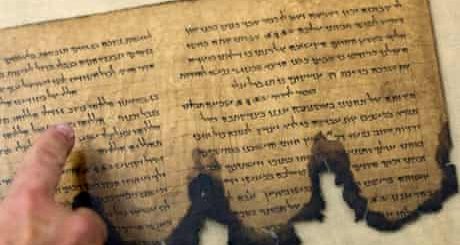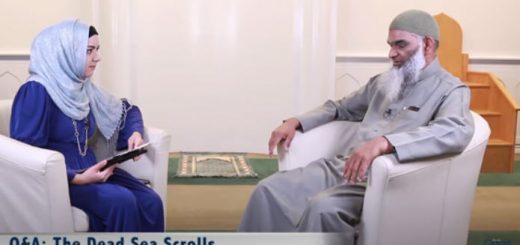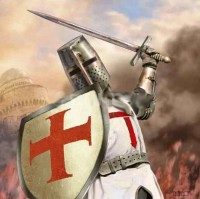Fun Facts about the Dead Sea and the Dead Sea Scrolls
Not all history is as dry as desert dust. Some is sprinkled with murder, mystery and intrigue. Now, I’m not saying the story of the Dead Sea Scrolls reads like a James Bond novel, but if written correctly, it’s not far off the mark. And if you’re looking for a romp through history with a scriptural bent, you’ve simply got to tune in to the story of the Scrolls.
Sooo . . . can they be interesting and fun?
Absolutely. But don’t trust me; read the following fun facts and decide for yourself:
1) The Dead Sea is dying—now go and figure that one out. To begin with, at roughly 1400 feet below sea level, the Dead Sea is the lowest place on the surface of Planet Earth. And it’s getting lower. Surface evaporation and reduced inflow from the Jordan River have caused the level to drop and the shoreline to recede. Over the past fifty years, the sea has lost one-third of its volume. The only thing that seems to be increasing is its salinity, which at 35% is eight times that of the world’s oceans. Few microbes can survive the concentrated mineral salts, and anything larger hasn’t a chance.
2) The desert around the Dead Sea receives an average of two inches of rain per year, and mean summer temperatures approximate 1000F. It is barren, dry, and sun-bleached. The only thing that grows on the shores is scant, stunted brush and hotels. Oh, and sinkholes. Well, sinkholes might not exactly grow as much as they (now, stay with me here) sink, but they are a new hazard in the area. Three thousand of them pockmark the area, and an equal number (or more) of subterranean cavities are believed to exist, even now, as we wait for them to collapse. What happens is this: As the sea level sinks, fresh water flowing down into the sea attacks underground salt deposits previously maintained by the brine of the Dead Sea. When the fresh water dissolves these salt deposits away, the resultant cavity collapses, frequently at the blink of an eye, sucking down everything above it. As a result, certain areas around the Dead Sea are becoming geological mine-fields.
3) The Dead Sea Scrolls were discovered at Qumran, on the Western shore of the Dead Sea. The scrolls were found in cliff-caves (some of these caves were manmade, others are natural limestone caves to the West). Many of the manmade caves are believed to have collapsed into the Dead Sea as the result of erosion. Whereas the water’s edge used to lap at the foot of the cliffs (sometimes lapping so much that the wall of sandstone—caves, contents and all—crumbled and slid into the sea), the sea has now receded, so the cliffs can now be approached from below as well as from above. Two thousand years ago, when the scrolls were hidden away, that wasn’t the case at all.
4) The area of Qumran is comprised of the cliff caves and the ruins of the complex, known as Khirbet (i.e., ruins of) Qumran. Some believe Khirbet Qumran was a residential complex, others think it was a fortress constructed along the nearby trade route, still others claim it was an aristocrat’s luxury estate. The most accepted opinion is that it was a wilderness retreat for a monastic Jewish group known as the Essenes. Even that concept has its detractors: Some say the Essenes weren’t really all that monastic (unlike Christian monks and Catholic clergy, who profess lifelong vows of chastity—as did their fathers, and their fathers before them), and others claim the occupants weren’t even Essenes. Whatever the reality, the complex contained everything from stables to scriptorium, from baths to bedrooms, from kitchens to kilns, and from dining hall to . . . to other rooms that start with a “D.” The archeological excavation of Khirbet Qumran exposed everything from an advanced system of aqueducts and cisterns to a communal library and reading room, which were no doubt the centerpiece of the religious community. Situated one day’s walk from Jerusalem and only two hours from Jericho, Khirbet Qumran was by no means isolated from other Jewish communities and centers of learning.
5) If not the Essenes, then who were the keepers of the scrolls? Actually, it doesn’t really matter. The Dead Sea Scrolls describe the keepers of the scrolls as the “Sons of Light.” Such metaphorical language is typical of Semitic languages, both then and now. By comparison, we find the Bible describing believers as “sons of the king” (Matt. 17:25–26) or “God’s sons” (Matt. 7:9 and Heb 12:5), God’s elect as “sons of Abraham” (Luke 19:9), and students as “sons of the Pharisees” (Matt. 12:27, Acts 23:60). Elsewhere in the Bible, we find “sons of the kingdom” (Matt. 8:12), “sons of peace” (Luke. 10:6), “sons of this world” (Luke 16:8), and “sons of thunder” (Mark 3:17). In modern Semitic language, many of us would be “Sons of the rhythm method,” or “Daughters of ‘Trust me.’” Now, I haven’t verified this with my parents, but it wouldn’t surprise me one bit if I turned out to be a son of “nothing-good-to-watch-on-TV-tonight. Gee, hon, what-shall-we-do-to-pass-the-time?” But I digress. The point is that the keepers of the scrolls were known as the Sons of Light, and most scholars presume these “Sons of Light” were Essene Jews.
6) The Dead Sea Scrolls were excavated from eleven caves (five of them natural limestone; six of them manmade) between 1947 and 1956. The scroll fragments range from relatively complete manuscripts to pieces of parchment containing only a letter, or even just half a letter. This wealth of fragments represents over 900 manuscripts, but many scroll fragments are so insignificant as to be virtually if not totally useless. The initial find was in Cave 1, which contained ten scroll jars. Nine of these jars were empty or filled with dirt, but the tenth housed the original seven scrolls discovered at Qumran. These were complete scrolls, unlike most other scrolls, which are fragmented. Now, some scholars believe the find at Cave 1 indicates that the Essenes were massacred. They believe that the scrolls in Cave 1 prove the Essenes never returned to retrieve their precious scriptures. Hence, they must have been wiped out, to the last man. I have a different theory. I don’t look at the one full scroll jar, but at the nine empty ones. I believe some of the Essenes did survive the massacre. The survivors would have been forced to sneak around at night. They could not afford to light a candle or torch, out of fear of alerting the rampaging Roman soldiers to their presence. Under these conditions, the survivors would have recovered their scrolls at night. Unable to see in the dark, they simply missed one of the ten jars.
7) How many other scrolls were found? In rough scientific terms, oodles and oodles. Cave 4 yielded 15,000 fragments of more than 800 manuscripts. However, the scrolls in Cave 4 were in such poor repair that some believe Cave 4 was a genizah—a scroll dump where the Essenes deposited worn out scrolls to molder away, according to the dictates of their faith regarding the disposal of sacred scriptures. These scroll fragments were chewed into pieces and scattered by rodents and insects, not to mention used as nesting material. They were shredded by two thousand years of wind and weather shifts, and the fragments that survived were saturated with urine and coated with feces from the bats, rodents, and birds that occupied the cave. These fragments were in such decay and disarray that for many years researchers believed they represented far fewer manuscripts. Only recently has the scrolls team been able to make sense of many of these fragments.
8) The Copper Scroll, a list of the Essenes’ treasure troves, was discovered in Cave 3 in 1952, but nobody knows if any of the listed treasures have ever been found. And these treasures must have been considerable. Remember, we’re talking about a religious group that required their recruits to turn all of their worldly possessions over to the communal treasury. Two centuries of taking everybody’s everything adds up to a whole lotta loot! So much, in fact, that the Essenes stashed it away not in one cache, or even in a dozen caches. According to the Copper Scroll, the vast treasure of the Essenes was divided into more than 60 caches. Hm. Makes a person want to take a stroll in the Judean desert with a turbo-charged metal detector, doesn’t it? On the other hand, some scholars believe the Copper Scroll lists the treasures of the Jewish Temple. Whichever it is, the value of the treasure is estimated to be in the billions of dollars, not counting the historical value. Perhaps it was pilfered by the Romans at the tips of their swords, perhaps it was retrieved by surviving Essenes, perhaps it lies in hiding still, awaiting its discoverers. We may never know.
9) In 1956, Cave 11 yielded thirty manuscripts, among which was the nine meter-long Temple Scroll. Wow – that’s as long as two SUV’s laid end-to-end or (and here’s a sobering thought) as long as a Nile crocodile. Fortunately, ancient scripture wasn’t written on crocs. It doesn’t take much imagination to figure out which would be easier to hold down. A few papyrus fragments were also discovered in Cave 7 (these fragments were the size of a croc egg squashed flat by a Nile hippo and picked clean by a hungry egret). The Cave 7 papyrus is unusual in that a) they were papyrus, rather than parchment; b) they were not stepped on by a hippo or pecked at by an egret; and c) they were written in Greek. This (the papyrus and Greek combination, not the hippo and egret factor) prompted one scholar (José O’Callaghan) to suggest that these fragments represent New Testament material. However, the Cave 7 papyrus pieces are too small to make sense of them, so O’Callaghan’s claim appears to be based more upon wishful thinking than upon scholarly analysis.
10) And now . . . a taste of their times. Beside the orthodox Sadducees and progressive Pharisees, the Essenes represented the third main school of Jewish thought at the period of Christian origins. They were devoted to ritual purity, monastic lifestyle, exhaustive worship, Mosaic law, meat and metal. We’re not talking about pacifist vegetarian monks here – the Essenes spent generations gearing up for an apocalyptic war in which the “Sons of Light” would obliterate their enemies at the points of their lances and the edges of their swords. The Jewish revolution against Roman rule raged from 66-73 CE. When Jerusalem fell in 70 CE, the Romans destroyed the second temple (Babylonians destroyed the first temple in 586 BCE, the Jews rebuilt it seventy years later). The Romans spent the next three years mopping up insurgence in the Holy Land, culminating in their horrific victory against Masada in 73 CE. Given the war, the Essenes had good reason to hide their greatest treasure – their sacred scrolls. Evidence suggests they hid the Dead Sea Scrolls in the caves around Qumran in or before 68 AD (for Christians), 68 CE (for non-Christians), three score and eight (for Abe Lincoln), and the high side of six dimes for the rest of us. Then they were destroyed. For nearly two millennia the Dead Sea Scrolls lay undiscovered. So what, exactly, do these scrolls contain?
11) The Dead Sea Scrolls can be divided into three categories – biblical scrolls, non-biblical scrolls and sectarian scrolls. The biblical scrolls are 1000 years older than any other Old Testament texts, and represent all of the books of the OT except Esther. Now, keep in mind, when we say “biblical” in reference to the Dead Sea Scrolls, we’re talking about the Jewish Bible, meaning the Old Testament. None of the scrolls, other than the aforementioned questionable fragments discovered in Cave 7, represent New Testament books. Having said that, 207 out of the 930 scrolls found at Qumran are biblical scrolls. The non-biblical scrolls contain new psalms, the retelling of biblical stories, mystic tales and biblical interpretation. Sectarian scrolls, such as the Rule of the Community, were written by and about the keepers of the scrolls, the aforementioned “Sons of Light” whom most scholars presume to be the Essenes.
12) Science and the Dead Sea Scrolls. Now, here is where it gets interesting, from a technical point of view. The scrolls have been dated by paleography (the study of age-indicative, period-specific writing styles) and Carbon-14 analysis. From this we have learned that the biblical scrolls date from 250-150 BCE; sectarian and non-biblical scrolls date from 100 BCE-70 CE. Scroll fragments have been matched by paleography, scribe-specific writing styles, C-14 dating, and even mitochondrial DNA analysis of the parchment they are written upon. Those scrolls that are blackened beyond readability have had the text teased out by multispectral imaging. DNA analysis has determined that biblical texts were written on bovine parchment, sectarian texts on sheep parchment, and non-biblical texts on sheep or Ibex. Wow, what a worthless piece of information. But no, really it’s not, and here’s why: there is no reason to believe cows were raised at Qumran. There were no cow bones found in the communal dump, and it is the wrong terrain for them. This suggests that the biblical texts were not penned at Qumran, but were imported from other Jewish centers of learning. If the DNA of the scroll parchment can be matched to cow bones at other archeological digs, we may someday learn where these scrolls came from. In the meantime, scientists are using neutron analysis to match the chemical signature of scroll jars with kilns and pottery at other archeological sites. So far they have learned that some of the scroll jars were made at Qumran, but others not – more evidence that some of the scrolls were imported from outside the immediate community.
13) The original Scrolls Team of eight scholars was headed by the Dominican Priest, Roland DeVaux, the head of Ecole Biblique, a French Catholic theological seminary in East Jerusalem. DeVaux was widely criticized for withholding the scrolls from public scrutiny, by outside scholars as well as by members of his own team, and it was during his tenure that charges of academic scandal and theological bias were first leveled. Huh, imagine that – a priest allowing his religious convictions to prejudice his interpretation of scripture. Hard to imagine, cough, cough. Then, after the Six Day War in 1967, Israel expanded its borders to the Dead Sea and laid claim to the scrolls as well as to the archeological site of Khirbet Qumran. Over the next few years, the focus of the charges of academic scandal and theological bias switched from the Christian controllers to the new Jewish custodians. Roland DeVaux refused to work with the Israelis, but lost leadership over the scrolls project when he died unexpectedly (a little too unexpectedly, if you ask me) while undergoing minor surgery. The charges of obstructing full and unbiased disclosure of the scrolls’ content have remained upon Israeli shoulders to this day.
14) So, where does all this leave us? This leaves us with the greatest archeological find of the twentieth century – a library of scriptures with an intriguing and bloody history, which have been the subject of some of the slickest scientific analysis known to man. Paradoxically, these scrolls convey a message of such importance that the Jewish keepers of the scrolls two thousand years ago died to preserve them, yet modern Jewish custodians struggle to convolute or conceal the religiously-revolutionary, theologically-threatening secret of the scrolls. And the final step in the history of the Dead Sea Scrolls will be exactly this – exposing their secret to the world.
Number of View :1954
















